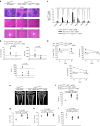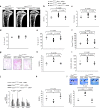Effective Small Interfering RNA Therapy to Treat CLCN7-dependent Autosomal Dominant Osteopetrosis Type 2
- PMID: 26325626
- PMCID: PMC4877447
- DOI: 10.1038/mtna.2015.21
Effective Small Interfering RNA Therapy to Treat CLCN7-dependent Autosomal Dominant Osteopetrosis Type 2
Abstract
In about 70% of patients affected by autosomal dominant osteopetrosis type 2 (ADO2), osteoclast activity is reduced by heterozygous mutations of the CLCN7 gene, encoding the ClC-7 chloride/hydrogen antiporter. CLCN7(G215R)-, CLCN7(R767W)-, and CLCN7(R286W)-specific siRNAs silenced transfected mutant mRNA/EGFP in HEK293 cells, in RAW264.7 cells and in human osteoclasts, with no change of CLCN7(WT) mRNA and no effect of scrambled siRNA on the mutant transcripts. Osteoclasts from Clcn7(G213R) ADO2 mice showed reduced bone resorption, a condition rescued by Clcn7(G213R)-specific siRNA. Treatment of ADO2 mice with Clcn7(G213R)-specific siRNA induced increase of bone resorption variables and decrease of trabecular bone mass, leading to an overall improvement of the osteopetrotic bone phenotype. Treatment did not induce overt adverse effects and was effective also with siRNAs specific for other mutants. These results demonstrate that a siRNA-based experimental treatment of ADO2 is feasible, and underscore a translational impact for future strategy to cure this therapeutically neglected form of osteopetrosis.
Figures





Similar articles
-
Effect of Allele-Specific Clcn7G213R siRNA Delivered Via a Novel Nanocarrier on Bone Phenotypes in ADO2 Mice on 129S Background.Calcif Tissue Int. 2024 Jul;115(1):85-96. doi: 10.1007/s00223-024-01222-3. Epub 2024 May 11. Calcif Tissue Int. 2024. PMID: 38733412
-
Chloroquine increases osteoclast activity in vitro but does not improve the osteopetrotic bone phenotype of ADO2 mice.Bone. 2021 Dec;153:116160. doi: 10.1016/j.bone.2021.116160. Epub 2021 Aug 28. Bone. 2021. PMID: 34464779 Free PMC article.
-
RNA interference therapy for autosomal dominant osteopetrosis type 2. Towards the preclinical development.Bone. 2018 May;110:343-354. doi: 10.1016/j.bone.2018.02.031. Epub 2018 Mar 6. Bone. 2018. PMID: 29501587
-
CLCN7-Related Osteopetrosis.2007 Feb 12 [updated 2022 Jan 20]. In: Adam MP, Feldman J, Mirzaa GM, Pagon RA, Wallace SE, Amemiya A, editors. GeneReviews® [Internet]. Seattle (WA): University of Washington, Seattle; 1993–2025. 2007 Feb 12 [updated 2022 Jan 20]. In: Adam MP, Feldman J, Mirzaa GM, Pagon RA, Wallace SE, Amemiya A, editors. GeneReviews® [Internet]. Seattle (WA): University of Washington, Seattle; 1993–2025. PMID: 20301306 Free Books & Documents. Review.
-
[Osteopetrosis, from mouse to man].Med Sci (Paris). 2004 Jan;20(1):61-7. doi: 10.1051/medsci/200420161. Med Sci (Paris). 2004. PMID: 14770365 Review. French.
Cited by
-
Small non-coding RNAs-based bone regulation and targeting therapeutic strategies.Mol Cell Endocrinol. 2017 Nov 15;456:16-35. doi: 10.1016/j.mce.2016.11.018. Epub 2016 Nov 23. Mol Cell Endocrinol. 2017. PMID: 27888003 Free PMC article. Review.
-
Autosomal dominant osteopetrosis.Bone. 2023 May;170:116723. doi: 10.1016/j.bone.2023.116723. Epub 2023 Feb 28. Bone. 2023. PMID: 36863500 Free PMC article. Review.
-
Testing the Cre-mediated genetic switch for the generation of conditional knock-in mice.PLoS One. 2019 Mar 13;14(3):e0213660. doi: 10.1371/journal.pone.0213660. eCollection 2019. PLoS One. 2019. PMID: 30865697 Free PMC article.
-
Effect of Allele-Specific Clcn7G213R siRNA Delivered Via a Novel Nanocarrier on Bone Phenotypes in ADO2 Mice on 129S Background.Calcif Tissue Int. 2024 Jul;115(1):85-96. doi: 10.1007/s00223-024-01222-3. Epub 2024 May 11. Calcif Tissue Int. 2024. PMID: 38733412
-
Genomic Medicine: Lessons Learned From Monogenic and Complex Bone Disorders.Front Endocrinol (Lausanne). 2020 Oct 9;11:556610. doi: 10.3389/fendo.2020.556610. eCollection 2020. Front Endocrinol (Lausanne). 2020. PMID: 33162933 Free PMC article. Review.
References
-
- Anasagasti, A, Irigoyen, C, Barandika, O, López de Munain, A and Ruiz-Ederra, J (2012). Current mutation discovery approaches in Retinitis Pigmentosa. Vision Res 75: 117–129. - PubMed
-
- Del Fattore, A, Cappariello, A and Teti, A (2008). Genetics, pathogenesis and complications of osteopetrosis. Bone 42: 19–29. - PubMed
-
- Lu, X, Yang, X, Huang, X, Huang, C, Sun, HH, Jin, L et al. (2013). RNA interference targeting E637K mutation rescues hERG channel currents and restores its kinetic properties. Heart Rhythm 10: 128–136. - PubMed
-
- Leslie Pedrioli, DM, Fu, DJ, Gonzalez-Gonzalez, E, Contag, CH, Kaspar, RL, Smith, FJ et al. (2012). Generic and personalized RNAi-based therapeutics for a dominant-negative epidermal fragility disorder. J Invest Dermatol 132: 1627–1635. - PubMed
Grants and funding
LinkOut - more resources
Full Text Sources
Other Literature Sources

